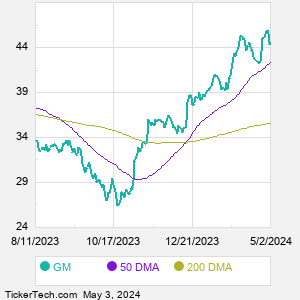General Motors designs, builds and sells trucks, crossovers, cars and automobile parts and provides software-enabled services and subscriptions worldwide. Co.'s automotive segments include: GM North America and GM International. Cruise is Co.'s global segment responsible for the development and commercialization of autonomous vehicle technology. Co. provides automotive financing services through its subsidiary, General Motors Financial Company, Inc. (GM Financial) segment. GM Financial provides retail loan and lease lending across the credit spectrum. Additionally, GM Financial provides commercial lending products to dealers including floorplan financing and dealer loans.
When researching a stock like General Motors, many investors are the most familiar with Fundamental Analysis — looking at a company's balance sheet, earnings, revenues, and what's happening in that company's underlying business. Investors who use Fundamental Analysis to identify good stocks to buy or sell can also benefit from GM Technical Analysis to help find a good entry or exit point. Technical Analysis is blind to the fundamentals and looks only at the trading data for GM stock — the real life supply and demand for the stock over time — and examines that data in different ways. One of those ways is to calculate a Simpe Moving Average ("SMA") by looking back a certain number of days. One of the most popular "longer look-backs" is the GM 200 day moving average ("GM 200 DMA"), while one of the most popular "shorter look-backs" is the GM 50 day moving average ("GM 50 DMA"). A chart showing both of these popular moving averages is shown on this page for General Motors. Comparing two moving averages against each other can be a useful visualization tool: by calculating the difference between the GM 200 DMA and the GM 50 DMA, we get a moving average convergence divergence indicator ("GM MACD"). The GM MACD chart, in conjunction with the chart of the moving averages, basically helps in visualizing how the moving averages are showing convergence (moving closer together), or divergence (moving farther apart). |



